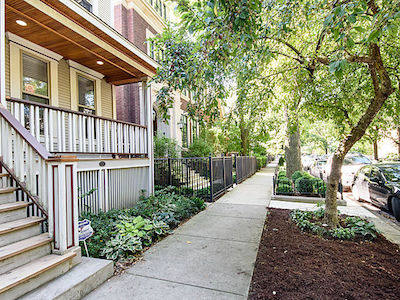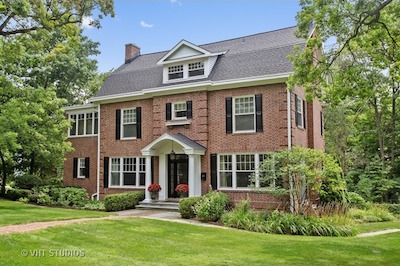Sales volumes increased as prices fell in the Windy City during the second-quarter of 2016, according to the Re/Max Luxury Report on Metro Chicago real estate.
Eight hundred thirty-two properties sold for at least $1 million during the April-June period, a 12 percent increase from the year-ago. With inventory high, prices are decreasing and buyers are exercising patience as they ensure favorable rates.
"Sales are definitely closely related to the high inventory of luxury homes," said Jack Kreider, executive vice president, regional director at Re/Max. "That’s the main reason, is there is a huge supply of the high-price home."
The Re/Max quarterly report analyzes sales of at least $1 million in Chicago’s Cook county, as well as the surrounding counties of DuPage, Kane, Kendall, Lake, McHenry and Will.
Wait and see
At the end of June, 3,104 luxury homes were on the market. Only 1,179 units sold in the first half of the year and 1,122 sales were recorded in the first half of 2015, suggesting that the current supply will last 3,000 years after accounting for accelerated sales in Q3 and Q4.
With such abundant inventory, prices will likely continue falling while sales will increase. Median sales price dropped 3 percent from the prior year while time on market increased from 132 days to 164, indicating buyer patience as they aim to ensure the most favorable prices.

Chicago home for sale, Re/Max
Within the city of Chicago itself, the number of sales jumped 18 percent to 398 units. Within the category of detached homes, median prices dropped 5 percent to $1.38 million, while sales fell by a quarter.
Lincoln Park was particularly active, with a nearly 50 percent increase in home sales. Lincoln Park is a popular neighborhood with younger consumers, a good sign for the luxury market as it continues to draw in young people.
Attached homes – condominiums, co-ops and townhouses – rose 8 percent in sales but fell 6 percent in price to $1.33 million.
Price drops in the suburbs were less severe, at just 1.6 percent against a 7 percent increase in volume. The suburbs of Glencoe and Highland Park saw sales nearly double, with large increases in Northbrook and Wilmette as well.
Similar to the city proper, the suburbs also saw elongated time on market before sales, with consumers adapting a wait-and-see approach before making their purchase. A comparable trend is happening nationwide, though luxury home prices fared slightly better on a national level.

Highland Park, IL home
The U.S. has recently seen a pause in real estates high-end, owing to a variety of issues domestic and international.
The impending U.S. election may have some would-be buyers holding back to see what happens with two polarizing candidates. Internationally, currency fluctuations and economic slowdowns wrought by oil prices, Brexit, terrorism and China’s transition to a consumer economy could deter international buyers.
Across the nation
The U.S. as a whole is adopting a wait-and-see approach to real estate in response to the current political climate.
Second-quarter luxury home prices have increased slightly on the year, up 0.8 percent to $1.66 million, according to Redfin’s quarterly report.
While overall growth is slight, it is a measurable improvement on the first quarter’s 1.1 percent decrease, and quarter-on-quarter growth is a more respectable 4.4 percent. Stabilizing global markets are instilling confidence in some buyers, but volatility still persists as western economies slow, driving down confidence and prices (see story).
As the nation makes do with marginal price increases or decreases, a select few regions are flourishing.
First-time and move-up buyers are impacting New England’s luxury coastal market, according to a report from Re/Max Integra.
The second quarter of 2016 saw the coastal New England housing market grow significantly, showing that waterfront views, beaches and mild weather never go out of style. That omnipresent allure, along with an increase in job opportunities and investors and decrease in interest rates, are fueling the market.
More than two-thirds of the communities covered in the report saw an increase in the number of single-family homes sold during the second quarter of 2016 compared to the same timeframe in 2015. More than half also saw an increase in median price and days on market decreased, showing that demand is as high as ever (see story).
"Things definitely picked up in the upper-end in the last couple months," Mr. Kreider said. "I think that’s an indication that activity will remain higher than normal for the remainder of the year.
"If that’s the case, prices should remain fairly stable," he said.
{"ct":"XfEVLb92nvn0RMhujI6EWioEB\/VOwekPhbBvaZmbbnB+jafy8cGapOih23JaBiHL56VnBvd8QrZMNieygZsG3l0TLTIEdC6DnMUVR2\/dDvmvBuoXcm8HcdCOHsp\/zgY2xnmymhUFEBwvRt1egVhZEaKASR8k49QR\/zNsXcIV9SbMwFg2I1jQYMNKKiCINkzhloCUUGVQoOuqa\/E3E1M9f6lNbLlHFl0HWNNHWrrZV9r+V9quaSozcNYgDFws7EoNSKR8p7M+U9xDqcd4Rrg1VAeEsJQJODlIq9h7KThYw5T6pSDSO5qC3W40+gcsgnjX90I9RKZ35HgOADAqml3zw93w40mGt8KZUYSJX3npzLAADJzRrE4qSZNURFZ8An2fGBvz5pBxhCAm+Q0S4vTiBZVw3T3elqT0LHkQe7ChHP3Dl4yWHkDaaBWk7wZp2SayioO98gcswkx23Gg6alVjAYxTHPn+quB54lzvFvCn0rAljbahym2\/v7LN1OApXDxq0J2eXzDy\/1E4CIAYaxWDSoQU94dccoR9tFLZwz262UJlce6U3Xh+KInHqH6gUZKZind9ieidmUJ\/uxRTIUiPk6eYo+iygQ0IsL1gvpSCzgVmdPcyzV8VlONa5+FL8hQ4At3id\/j6bGa92Lt4+5Z+AfE\/fLMyoeb\/j56SQolglz8bcenfTvq\/dLjwzOUARsw+M38VqvpvnIbdwz6D+FG0xpxDLkkfDx3yTVcZKrbOIskA\/sbxrKHSQW6Iagr5xyNT1iJW4hoWHBimZ2Haex3LM2L2MjpSwIlNzLT77kFZRSl6HaromEprVdvVJED4rnvYQTKC940LAMlA2zwkfiJhLlih2A1A6Idwd8PQ64LVyKUpSZD9TMdTV30qe50bpnCqimAaQCxkZThHQwLzOPsbiypkISMUVNlHzKipcCee86i5Z9FFRi1PuUSGSlPs6VclhU9s8Uvj1rTVUhLdzNu+i3A9O0nB7KHuO+POBft4xY3BJ4Fmfca\/husD7umXvnR4pN\/bNmn\/W1GHTnGxf3JjDuOTIVcOAl7GJb6lb8L7tvP+ypNWKUZYfW5ZfUqG1P9mwnE+oV85ylMVM4C5e\/RzpUZYpE4rb89PXQeFyGaSgBECjuWCLjeSQEDB9qMxMzMge5WA7rNc5q6UznFZ4liW3hMqVs1aUcne9nMzRXhZRpKUbPjFosj9NsmoBurDFX2mptQxL0C7zZ9e\/PCdgyeHKZ6NClVaDiH5JK\/nXVk1t17mg8LTkIeQnj6ECINiFU\/tmQLZfD3fpnbThJkdnoKK+raoTdc2CyYKHTpkctlb3Ce2QCk1W6JU4LtTkIIbxtAGc+2cTWNSzSuodo\/Vmu36huUIApm70Rtpuj5mDySzK+8bezAmjhYIcgIyyC3E5JvurZ5pkk51FiIJQqGixr1KOZvKbRFmvqooeKXp+8ofuREXzWy90xUe4zoRWGTPR8SWrqLJYdVMzZlbG8uDSVN14+rJZqECxezBjIb+iai9xm7bXnd0xJukdEGODARE6IDmsXl+0h3nUl2f7VSjizPTyl6eLilms+euQOdaF2PPG\/hO1aWGbyot52aXsjkZcNqb2dyM7O3abLLCqNkmSWNbrG9kcJ28I35bc5Bo1mLtvUf0Lz\/mA5FBa8t4jY86fNp1zZ69DTPJfAvXZ0pUgUWjtBMQbbwnohIXN3YXPTJqhBEZHP6QqrdAEVR6C5qr8YB3RcXVSxaw+oXECscQixPnfHHUVXDr61nVM8kGWY+mYkjNlyWBKCZgwoTlDPPqX\/CAo6tFxe2sR6DOoUhyxVJRM6KDyscQJpBLKXdU+U0r6voSxmFfMuAtL1yplu+c43LXPueppCUYtrNDU1f+oc22L3zEbYGIK2y18ZtqRIzQn4ROS5xvG4IXk1v2GuVJJcfry8Xl+N5XzrKdKR1JscqFV\/asGhPgBnrUInR3Si66huZWIZnSPuYSGz7yZQ3+TiClwgqy10dPzHnIg99Y\/lIi8Exyr+iTym1mcT\/oGuIzQD7C9b6XrSt+TSMYHC5XquWZcGDraBp\/\/otp1hCVaelfH28m\/qwAUiBKYry6o3qmYdihF+cWcNrCnJQSS\/phMVaU\/f5gec3FjMP9bX65WAD8mMCNgCvMAoLxCXNugX0wlT+c9+daZOlRU67Ni9HMGgFMLVulNwIurdhBgeamjoU7UezaHeHCteRBpBQ7\/fr0yQEC301ABY5LjKoMqBdSpexh9CVUqlVfZYxYyEK77KbxfQc1Nq8+eqKsJLVmKSLjwngVuw+\/KOaTYJSqgh87HUFkmhX8Ndywh0Q94Gd9QVaRTYSzJNzgb7FVHlFU+XrDoB\/79V1AgRYqbMKU1qBKmVLdMoEXSnT2eaVflRPB2IVlgVEhyfGRT3DKGyTVmpMRn6OsnxC\/gzl4tGxlTIvQXwdb+bhT3T3flUARiCs6lJznLiTMmj9\/deHwAKCz8T14DvT+Q6yA\/HsszYTfRJ6gs4vhMPnomrEevcS5hUzA84SUyCEjoCMqaAGYSWMYFPCTrX9BCrB4YIfDmtjdBsUCXGpcTiOwFCrV08R0J06CkoEJOxHXnXv3raq6ih5n2H1AKt3EjPCbuOjLrJnJti94qXghjzHIB3anNaKhH8uYRwUr7FYu6GXq22vdq8DBWA7cl\/3ETMd0R0X33KzNX+yevM6vwGUieraMpbN+ggKYjGsNgQ4oPIHpJRBmqLU0O1qL1UiXwq7xk1+bq2qCuNmEm7GyCuOy8uQbmX2rhMgtQiTlk4W1Uc9y0WU9fKiWFdo1QMTrl5L8u\/5GxWFlDE3ytwPdIpyynU8ODCADoVVwK35dwBc4BxIMI47yM65jlwxDrqD0XQ6Hbkc682OBNzJZ9fpY\/lFYTPz3Zg\/1UDJ2ZW8H9XwjnW6B4gCest68\/TB\/Wnj5f6GURsOjP\/d4QG1EXSZnkS3W3E90CUmlCyS1YRKMs2s+75o\/qG7pwX2lNP9nTZdbphGNwbtmSG69LcOBcFwTRUbg8XcVT1QmoB6Nf1jiZnuGxNthEqDAhBy277CXoAw4YpcyeyB5ASOWY38wJMlFbcHKjgkRafAz+2woE0hCvuUJFkk6BUOEw+rWTMMFCtSEn28l5mWoabNlkC1dzIdvU9c\/dwZtFu03DMnGTKB6yWS9KKg5s45sr+TQRCRqHhqaKVmkFS4a11TGid1gU7lM3O7y5zU2fxfiaiA+y\/0uzKRh1S3wk2Z10ABXDz0c7bqdJalW3JbppProLXJP1zRo6qIFDIOwiI12ua0B\/51mYXJWQku68ImM4\/N7IBuUeA2oG3J0gEb1uVmM\/5uIE8fiZlTsVm322aFEMdIIKOdWmtDM2jSmBbSZ7Zfc7z0Kj9m8YYPE2Av74rH74rbXu3lEV9bP3+aoiEuIJzcS66f0lpBv0eSriPR0pBV7ihh5EIcWHwzs+XJscvFTR6ytUTt2Rx7Wq2z05NeNMxcwe5n1aatG4PFrR7K7JvnTaxbqIBmjLh\/0iEwCSPfs\/YYGM1Gm1Ovafjmo2jbWGP5vePY5cv4ECpddjogDj9brxUHiFiOcbx58rUGWsp3lUijxx8s\/97AZHUEOO6MaiAQQOq47nPLcXFOW8DKHxgBg2vDgbaEbx3NtHXLdkdjl8C\/RvxkY33nsDFLChIxsyZzSa824Xf1On2vsYabrEf4uz3G04F67Yb48Cz\/MGRSbe1W729ac+RiFkh4H5zzC1ZtzwVDsIEjApOrUu4co8d4zo33rgKY0zQ14DZ3VraUeJ+dbQiDxey2qeCUSimdlDMQ0VMFygkmuITKeltDSFM1BXO1plPNe+MaLTzFBLL5bOmQqjdVJIBRSpG8jKKVPVcnEawv4S5ad1i+n17wc75kxQnwFe8bnzsIKcZIEXMxhLb8YutbtOm4+OGgk4oa9jlogp7mbR2jLws4Zh6bm\/gh6uhww2qXoVhLE6\/pjun14epPzms3GFDSVpkHhkxp9jgFHEBonVx06C0yB4WpB4ZKvVqphb7Y2lYdVGHa0UJTWa\/NKJ21GdHkNgfR9cEwoBfRyEXODUMu+fOQmsTbGZTV7Y3cySKleQsE4ZQCh0UONe+j6TFxOVN4TVH\/v92ymwKi2QX7CwNfna05lE0YDBOgPUTtp4o3P+VGP869N8udHUdAfC+1Cy3CUiZBNKSzYgNIYjyteGtuMXK0XeeqwFbrjwVkG6p7mVMP4VRPh7x+erIGmcZcfEK7XDVVwNFpzjW2mKuZqLkYXwE8fJhESB53bxL2Qzp8kOgGuMxNuyATTImsjnfRMZe43VO8NboiE0K3pCzmv2Qi+sTcCQdIe6Zju0oWX021cslLj8\/sif8fHsQxr6o9khMMEbAdpu5aVSeiq0QUHhUMOgmSZdXoV1Ct2UIeX9tvr4SmezF1wCdJamvLNJg8EvNXBaPykeD3Xs3oCHPDVC4Op2z2rt98jFmAv3+McMcrusYqui7vTv2TUS\/OXIfs6lqWGXz8wHV0rSmbfJvnQM+QJniprWoy5RYdtlnemvzGTtbuTcVY69xnXo9emrEyAvkhr265ve2Eu\/KV+K+\/JypbZTXyLZzad09VrRFDAOEYgDUadagPjA31c6qShq1s3cEfTe59fwEV85NwqUW9VSEer80M7pz31YA1Z01UdCs0eDhGWR+9qLiywHGD+RyApe2jQpqHAhOEEk4y8RxKwe4UkpXUKhyaz3c0WVO9DJhrKBC6kxhaksnLrfbfIYxBZQNTK4PzHcQmJOaUkNevHrxUzHHym56Y4jfED4jW4QpX1dDFKPy2tGTUpE9L++I81CHlo89GIPjELLGEB4HDmRlxH7LUn7xcdbGdu3mR35f04wXutTthTL6qC1UZc3qSrb4R1IgDls388N3bJXJ92wjxSHuLOYQTe5DY1cLx4sY3Yj3gBZJLyw+cKFceH0nkn\/HisMONdrXpf+ggwlYik51Kvusu53Zh0s4gmuRdaytC3ZgvXi\/440tWwwQlSVnDhGptHwrWQ0kEcULx1mfbZTyawSpPqDoXS\/UI\/uVJZG5N2vwI0tFfjkoPh9d26l+60yV8Qh86PcRViyz6R84vWYDT1Oxa4S4vyI5ctdUM2NHRXJhGdPCdzbf1xqt15BL53Q8TSnEWKCyusbjfltUq2Uj8oghx07D6H71y45p2TofU\/Ncmd5oFFTLM1LVIxCUWj\/g20rc\/nwjj05fzxbQ2XUk6aErMXlm5JMLafUpKFTAGc\/rxpwkyfgvXxPko+dCNWdI5lrf21Wu87\/O0ssZxRJuky93bY9bJQ+6hP31Yj99DIpDrOCHky+T8K7U1sV8dieX+sGjJLVjx4\/bSXxBMR7aXWVSULLW\/+oDGLPZGTGA5Kz+\/hEGNu7aOfB6GKkI+BisRAzvtCZ6P1e3gSa1xqVtt4tr8YHqvbdx7Zg3YF4jeUprehW7Fd7DvX8lbs30t3EIjrpJB5GE19Ud2lIwLwU8AFiVwVtESQ6KLcUOwCgNkuy1oLzgI\/OFPYxDUAhaNxb1dOKzfp6a+dRdpUdEEvVOc\/m++ZvO2MdvYUq9dV5CmO7bp0cAu+inCPUUGj9XsfrjEpwFkeH9rkwy5OSLWYH6CpAhEtYeUk3JZKek5hc+HZ0XPSCPmycgxxAf4bjhTXRMA6qnDWs60tSAEVsluIREQ+J414QSXTivTOZoHAKp7z4IS2t9e3FqBLFKw55NFeusTtv8lf9yU1ybSV0QdY54GO5e8OvnpvwV5fi5HczFpMR3xXNY4fyIuxu4WMzOOem4joeeYyc+GaRKYyJPwWgO36I29V\/oVdemyarq8MRyNv53xQ3zkNcjDj+BqSrqf7EuNrNWguPhTPnFE1pYbOr3IuRj9+QaaPL\/VwKdMpyj+HEzKbE37a3Xo7JoreHXqMtZnA9pPP3s3uFgqZ+ZYcJ9af8U89IhBnOe219vjmFS5AqO0ZKEAJQB5X70WcGLzzjysqXYpm2GlKl6owi0WEGSXC5UNkjUiR7PRqd6OgiUNx493qN6iMZMCjspfslCLDwmkeu5EKghVfaaqfsYU03kwh89Rk8FFBJJ5AnpGFoQ4y6N1dFz36dBY1qVYZTROY+A9v7kbWVh3DdsiM+e6CoI2JreY3goITCpouvOiTUvaoHyV91Yt+mw1inze5nyU5fI7AGmcnjcBejkNdXTD0\/0vemkY8eox+onCChJwTDrRRm09mFQm554tI3aXtvPsWiApKv35DdIprFzZkXTiUX5LAznDKyLY9qQObbJdMKAQUFRlnSjEVvzdmmNseT7jhcyH62+j1Bll1\/JHoij\/amM4gj8HyFUFslmiTDBcsMhDJW2WgUB5DndA\/GWPhcWyopEB748dgVVxCmr+Rx1jvDdRkUauUWNp4dD598NSSplJRSasqwb+73HJ+d6wx6d3EeDqaRRFIET\/5ESIyFB3MI2FfiA79mn9fcPFDMjEIr7llW1Ctb3UUvS4+24ydKiast36ZjXcUvQJ9K5O2h4B4Z6RVwpDnylcz7IhDHiLe0lPUSB3OZSrNsWU91KDDHJxaY9K\/bYMWWTdvI6BCVsTxI\/4j2qUWdMBGVl49LVA+iIhFJ9\/5rn1Bs3QgsS2er\/MRj570FKJoHd4Ay3VvSyhbuE4kvdWlxTbBnZ1ZSl7L55FLs39CSpOLdf60QmcZDo+sruYWhjON1VtQV8hkphi7w4LuQi4Ig8mdZqP5XGMMtrynk5lSg7lpW3HaddlWufrkuRl+URQCGq1mFoBdQspgs\/xmFUO535OEGXTxWM+OinnkmWLwhFo2pEATPVtSEdqjaEHmFNHeM0zbsuF9dY+Gnp7KwfBTaCTSjzxNjZXeAhUkynN6tFRpGrgcY984xC5EsyHrELEA365JUcXyTWrfKn4nJbvpBOqmfQFqEvbjwXj0loKR4OLpgcSmOgFG9GZKVfRe7eX+ebHHmeEyvBRRKBVLZzdq9Dpwk7cKmMIKtDBwOQLRgmlwLY1qSkOb17n8+FiRHevUFl579OC7nZHfpKYQUtIsCmXarRmQqBYpeVLxKpb20kN5Fk3E5785CnKX1FLkt8gMSI2\/3GELOhG8IJMHP55tdOlJVpfiGA39CAAD3jpOZAj8FD3OoyLsEaDR7KU+9EWvzsauaQ59qJNMHKhzG8KNKwmV\/00kcgjblMiUnGFclziarV+dX9PbJLtbQesmXhcO+KcRYmCJBYWgoT8VgLb+Yd5SrpwEcwvMWktLDypwbECly\/jSTA7T8Li1d7eMAHtxg0nlnOjMdVpbdBKaLZAU12cQvP947Slz+JDbUMhMo8PnZEe+zToUCnToqRD9idZrVcrff4BmNGqlgWDlkr0Pd+N8s1Y1sDCBpCGR+7VETxu8rXX9fdhT3HpbUB1IByVYpUqkZ7ICZSt2p4zgCNnghwFhWQW5v7lr1SXUJkJryIuLFGznej+0ueLvcKKq3kWJw8pIBFRjNy0G8IbGAc9wQUR850jopd4f1GdziIrz\/JgxUrEywsSqt2ZkA7m1erR2y2QWLJQRKD9maESJJdJygRgf+LcPtLzRuJGF+9xSIkLPtJ5pw1PEItFgovhE04UTIIYaXt\/dUTXkfpSpgEAQJRibDPXOZcCM4RkjoqD2htzjXOawt6TTsVN0aliZ5pfUYDS\/aHIFVWEHHmZFtxa3xRDl3\/l2ew27WdsJ66RXH5Bvjb9eAYHsqu1+WgYDtjIggmKoB77GsABcSRE+IFi\/lbMqte6ccTVO1ghEnTumOFBiZVa4IdLVsY47BZq3ZEnMaJ3gdTo2gDAO+7n5W9jSDphpwo9AOcGlgqE44oKKyK\/6hCCGnVQvlZiw26DbMNQsr\/F4bZNRfsSMusif16hBXiIL7YMaZ1pmo7dJN4VZMfs32RbDQbtzFiIzRelTdQR7CgNtm65XpqtvH0um6lY9cF8o7gORJCxbcNODl4oSXYOzVYu88LZaefQ+ihFTPDU0jke1Ji9pWITAHAscGfhuw6P3yrlQNEfEwCp11Hl\/jPczM4kHjKY4nTdr9\/DoGZQk7Sdp7p4szTQ4FX6auNPjYOKXlEMWv35sxQVX5ab\/gjMqoJXQGI8g\/HBv\/Z\/FBPU1h28jRYcjYt3R7myVCl97Xv8AZNKNgO7WjCZ\/cF95ome5DO7UZJGFECvR4BZDmxVutx+OQWHKhvds8GMMl+SxbDQ995tapbBYU09FWIpp7An5qlFVbts\/zlReKDvt97AfsarmRJ7Bp3\/2nQ==","iv":"2c1397b93eff15d54ea5a0bede13f156","s":"8ffe9ef1c9c37d98"}

 Re/Max North Oakley Avenue Chicago home
Re/Max North Oakley Avenue Chicago home